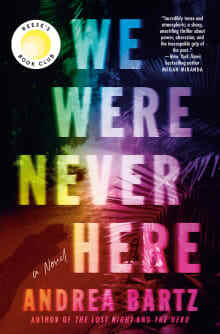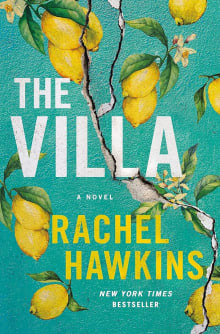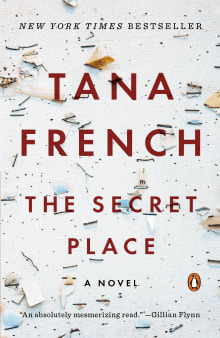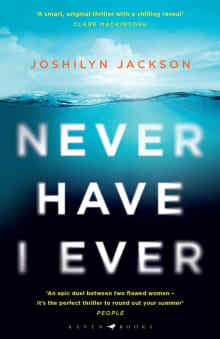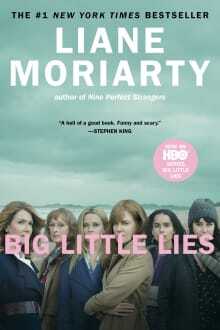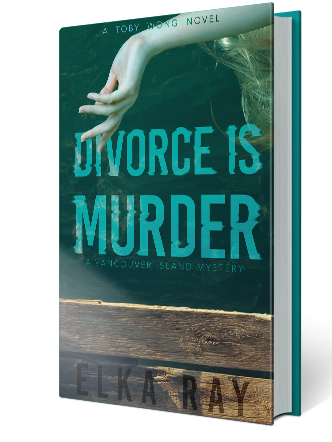Elka Ray's Blog
March 24, 2024
The best novels about friends hiding dark and dirty secrets – Shepherd Books
I moved around non-stop as a kid, attending a dozen schools by age eleven. As a result, once I stayed put long enough to make real friends, I stuck to them like glitter glue. As a reader and writer, I can’t get enough stories about female friendships, whether rock-solid or fraying. My latest novel involves childhood friends whose loyalty is stretched like a pair of latex gloves yanked off at a crime scene. The book grew out of a meme I saw on Facebook, captioned: “Real friends help you hide the bodies”. My first thought was: who would I help? Straight off, I thought of my oldest friends.
The books I picked & whyWe Were Never HereBy Andrea Bartz
 Why did I love this book?
Why did I love this book?
I adore unreliable narrators—and here we have two, a pair of best friends on a dream backpacking vacation. Something terrible happens on their travels. Even worse, tragedy struck the last time they backpacked together. Worst luck ever? Or something more sinister?
I love the dynamics between this book’s flawed besties and the growing uncertainty about who can be trusted. This is one twisty read that’s deliciously creepy. It left me feeling lucky to have good friends in real life.
What is this book about? Preview ListenAmazonMore buying optionsThe Villa Why did I love this book?
Why did I love this book?
Along with vivid characters, this book gives great house–a gorgeous and notorious Italian villa, which was the site of an infamous murder in the 1970s.
One friend, now hyper-successful, invites her old buddy to join her in the villa. The invitee becomes obsessed with solving the long-unsolved murder, and is increasingly sketched out by her old friend’s motives for asking her to come.
The story jumps back and forth from the swinging ‘70s to the present day, with tensions building in both past and present. The ending jump-scared me.
What is this book about? Preview ListenAmazonMore buying optionsThe Secret PlaceBy Tana French
 Why did I love this book?
Why did I love this book?
I’m a huge sucker for stories involving teen girls and secrets—and no one handles this trope better than Tana French in this wildly atmospheric boarding school mystery.
A year after a boy’s found murdered at a secluded Irish school, a note appears on a bulletin board reading: “I know who killed him.” It’s soon clear that a lot of the girls know something. What though?
I love the dark academia vibe, the claustrophobia, and the girls, so close-knit and determined. This is a gorgeously written tale of friendship, loyalty, lies, and betrayal, just buzzing with witchy teen energy.
What is this book about? Preview ListenAmazonMore buying optionsNever Have I Ever Why did I love this book?
Why did I love this book?
If you haven’t discovered Joshilyn Jackson, you’re in for a treat. Her Domestic Suspense novels are so sharp, cleverly plotted, and darkly funny.
It’s not old friends but new ones that wreak havoc in Never Have I Ever, as a glamorous “bad girl” newcomer joins the local book club—with ulterior motives.
This is a tale of the secrets people hope will stay hidden, manipulation, and below-the-surface danger, told with wry insights about human nature and crackling humor.
What is this book about? Preview ListenAmazonMore buying optionsBig Little Lies Why did I love this book?
Why did I love this book?
If anyone’s life seems perfect, you can be sure that it isn’t. Big Little Liesfollows a group of school moms, in a nice neighborhood, who bond and support each other while hiding massive secrets.
Liane Moriarty is a master at crafting relatable characters who feel real, like people you know from the school gates, only more glamorous. The idyllic suburban setting is equally vivid, while the twists keep coming. This isn’t a typical whodunnit but an exploration of the truths women hide from themselves and each other.
You’ve probably read it already, but if you haven’t–grab it.
I wrote…A Friend IndeedBy Elka Ray
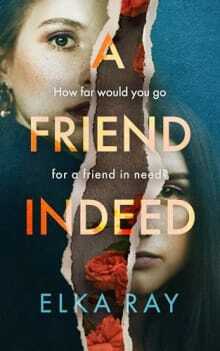
Your best friend killed someone. She needs your help to dispose of the body. You love–and owe–her. A friend in need is a friend indeed…
Delve into a twisty tale of loyalty, social disparity, and heavy secrets as a lifelong friendship is stretched to its limits. When Jo was jobless and penniless, Dana secured her a teaching job and thus an opportunity for a new life in an affluent Pacific Northwest town. So, when Jo gets a frantic late-night call from Dana, sobbing and desperate for help, it feels like a chance to help her friend in return. But the last thing Jo expects to see is her friend’s husband dead.
The post The best novels about friends hiding dark and dirty secrets – Shepherd Books first appeared on Elka Ray - Mystery – Suspense - Noir.
‘How to Nail a Twist by’ Elka Ray – The Stand Magazine
‘How to Nail a Twist’ by Elka Ray
February 16, 2024
How do you nail a twist?
For Thriller readers, the only thing worse than a twist you saw coming is a twist so out there it feels tacked on from a whole other story. I’m not pointing fingers but we’ve all been there—groaning on page 378, because the culprit was mentioned once on page 14, or they’re some lunatic with no clear motive, like the author got desperate to pin it on someone.
In the 1930s, Agatha Christie belonged to a writers’ group called “the Detection Club”, founded by fellow mystery author Dorothy L. Sayers. Members devised 10 suspense-writing rules, the first being: “The criminal must be someone mentioned in the early part of the story, but must not be anyone whose thoughts the reader has been allowed to follow.”
I think most mystery readers and writers would agree with the first half of this rule. Basically, a mystery is a puzzle. From early on, the reader deserves to know the game’s basic layout—i.e. all the main suspects. As the story unfolds, the author lays down more pieces. Some are backward and upside down. The reader tries to sift the clues from the red herrings and work out the culprit and why they did it. The villain’s motivation is key here.
The second half of the Detection Club’s first rule seems weird to modern readers. Unreliable narrators are the bread and butter of contemporary suspense fiction. Maybe Agatha, Dorothy and all felt that misleading thoughts were a step too far in tricking the reader. They doubled down, reemphasizing this with Rule Seven: “The detective himself must not commit the crime.” Nowadays, the gloves are off. Readers expect to be lied to. We’re used to wading through fake news.
However, while a point-of-view character can lie in dialogue, their internal thoughts must be honest. If they’re wondering ‘Who’s the killer?’ and they did it, that’s illogical and bound to annoy a clear-thinking reader. This explains why drunks, addicts, and traumatic brain injury victims are so popular in this genre: thanks to their blackouts, they can’t trust themselves, adding to readers’ confusion. If a POV character is culpable and knows it, the author must work harder to conceal their guilty thoughts from the reader.
A bunch of the Detective Club’s rules relate to plausibility. Nothing kills a twist faster than a reader thinking, really? A coincidence can set the story in motion but shouldn’t lead to a solution. Since I can’t mention book-twists without spoilers, let’s take a real-life True Crime example: the case of the Long Island (LISK) serial killer. After a young woman called 911 and went missing near Gilgo Beach in 2010, police discovered ten bodies, laid out nearby in rural brushland. They later found the remains of the 911-caller, but declared her death accidental—a strange coincidence, unconnected to the murders. While coincidences do happen in real life, story-wise, they don’t sit right, spurring wild conspiracy theories in the LISK case.
A good twist lands like an Olympic figure skater performing a quadruple axle. You gasp with surprise, relief, and admiration before the character and plot glide seamlessly on. You didn’t see that spin coming but should have. If you go back and reread the story, all the clues are there. You just missed them, dazzled by the lights, music, and sequins.
There are two mysteries to solve in my upcoming Women’s Noir/Suspense A FRIEND INDEED: Who killed Dana’s wealthy husband and who’s her blackmailer? I tried to follow the rules and keep the suspense spinning. I’d love to know your favorite fictional plot twists. If you read, write, and breathe Suspense and Mystery fiction, come and connect with me here.
Here’s a quick summary of my Suspense Twist Rules:
The culprit must be mentioned early in the story and be a large enough character.POV characters can lie in dialogue but inner thoughts that make the page must reflect their true knowledge.A coincidence can set up the story but shouldn’t lead to the solution.Make everything as plausible as possible by showing the characters’ motivations. People act in crazy ways—just make sure readers understand your characters’ out-of-the-ordinary actions and reactions.The villain’s motivation is everything. Suspense books aren’t Whodunnits but Whydunnits.Elka Ray’s Thriller A FRIEND INDEED is out on May 14th, 2024 with Blackstone Publishing. Elka works as a media consultant, editor, and illustrator. She calls two places “home”—Canada’s Gulf Islands, and Hoi An, Vietnam.
The post ‘How to Nail a Twist by’ Elka Ray – The Stand Magazine first appeared on Elka Ray - Mystery – Suspense - Noir.
January 2, 2024
Why do we write? Elka explains some of her reasons on Books By Women
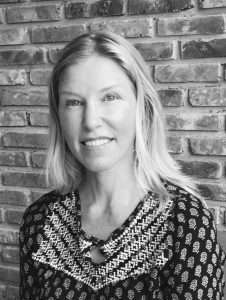 As a writer and reader of mysteries, it’s always the why that intrigues me. So many things humans do – including murdering each other, in many cases – defies common sense. The urge to write seems equally illogical.
As a writer and reader of mysteries, it’s always the why that intrigues me. So many things humans do – including murdering each other, in many cases – defies common sense. The urge to write seems equally illogical.
Why do you write? I’ve been asked this repeatedly. My answers change every time. All my reasons feel incomplete.
How I write is fairly straightforward. I spend a lot of time alone in front of a screen. An idea blows in like a seed, takes root, and grows. These seeds come from things that trouble me – news stories, niggling worries, moments that tear at my heart. Watching the story unfold is the fun part. Unfortunately, a lot of weeding and pruning are involved. It’s a long, slow process with uncertain rewards.
I could claim to read and write mystery fiction to better understand the world and myself, and to feel connected to other humans, both dead and alive. This is true. Yet there’s more.
I write to keep my mind busy – and out of other trouble, or as Zadie Smith said: “Writing is my way of expressing – and thereby eliminating – all the various ways we can be wrong-headed.”
I write to examine my hopes and face my fears. I write because it’s fun, at least some of the time…
Some days, the act of writing feels like a magic power. Other days it’s more of a curse. I’m not sure it’s wise to choose writing as a career. Unless you’re one of the rare, lucky few, the per-hour pay’s a joke. It brings rejection, disappointment, and criticism. Surely, there are better ways to fill your time than staring at a screen, alone, making stuff up?
Strangely, it seems I can’t think of any – or at least not for long. Something always pulls me back into a story.
I’d wager a lot of fiction writers had lonely childhoods, or felt they didn’t fit in. My family moved around a lot. I was the “new kid” time and again. As an only child, pre-internet, I had to entertain myself. Luckily, our house was jam-packed with books. I read a lot and daydreamed. Stories grow from daydreams.
Since I can’t fully explain what compels me to write, I’ve turned to other, better writers, to see what inspired them to put words on a page.
George Orwell, who loved lists, gave a bunch of reasons, including: “To be talked about, to be remembered after death, to get your own back on grown-ups in childhood, etc.”
Hmmm. The first two points seem over-ambitious and egotistical. I don’t care how I’m remembered post-death by those who don’t know me.
William Faulkner also wrote with an eye toward Posterity, or as he put it: “To leave a scratch on the wall”. Interestingly, I’ve found no women writers expressing this motivation. Perhaps they don’t wish to sound pompous? Or they’re simply too busy trying to make sense of this world to give much thought to Posterity?
Joan Didion said: “I write entirely to find out what I’m thinking…” while Isabelle Allende expressed a more altruistic desire to “write what should not be forgotten.”
George Orwell’s revenge as a motive to write seems interesting. Perhaps you’ve seen those t-shirts that say: “Careful or you’ll end up in my novel”? I’m guessing most writers who pen nasty characters have drawn on someone who ticked them off somewhere down the line. I’m not actually motivated by revenge (people I dislike rarely read!) but by a desire to understand why horrible people are horrible. Mean people are damaged, which makes them fascinating. This is why I read and write crime novels.
In Remembered Rapture: The Writer at Work, Bell Hooks explained the desire to write like this: “We may want our work to be recognized, but that is not the reason we write. We do not write because we must; we always have a choice. We write because language is the way we keep a hold on life. With words we experience our deepest understandings of what it means to be intimate. We communicate to connect, to know community.”
Unlike Bell Hooks, many writers talk about needing to write, like Jennifer Egan, who said: “If I’m not writing I feel an awareness that something’s missing. If I go a long time, it becomes worse. I become depressed. There’s something vital that’s not happening. A certain slow damage starts to occur. Kurt Vonnegut described writing as “therapy”, stating that writers “discover that they are treating their own neuroses”.
We all know the stereotype of the tortured artist, drawing on trauma to create art. Certainly, fiction writers need empathy, which we tend to learn through hard knocks. Anne Rice, who lost both her mother and daughter young, advised writers to: “Go where the pain is, go where the pleasure is”.
I read and write mysteries because their solutions bring me a sense of relief and renew my faith (however misguided) in an orderly universe.
Many other writers have mentioned this plus, including Gloria E. Anzaldúa, who said: “The world I create in the writing compensates for what the real world does not give me. By writing I put order in the world, give it a handle so I can grasp it”. Anais Nin said: “One writes because one has to create a world in which one can live”.
Let’s leave the last word to the late, great mystery writer Sue Grafton: “I write because in 1962 I put in my application for a job working in the children’s department at Sears, and they never called me back.”
She was onto something. By the time you’ve learned to write half-way decently, you’re probably unqualifed to do much else.
—
Elka Ray is the Canadian author of The Toby Wong Novels. Born in the UK and raised in Canada, Elka divides her time between Central Vietnam and Canada’s Vancouver Island and sets her fiction in both locales, to include Saigon Dark, Hanoi Jane, a short-story collection, What You Don’t Know: Ten Tales of Obsession, Mystery & Murder in Southeast Asia and a series of children’s picture books published in Vietnam.
Elka is also a freelance editor for Heritage, Vietnam Airlines’ inflight magazine, based in Hanoi, Vietnam; a designer and editor for MaiGuppy, a producer of picture books, greeting cards, and souvenirs in Hanoi; and a freelance writer and copywriter, whose clients include Vietnam Tourism Administration and the Four Seasons Resort.
When she’s not writing, drawing or reading, Elka is in the ocean.
CONNECT WITH ELKA ONLINE
Website: ElkaRay.com
Facebook: /elkaraybooks
Twitter: @ElkaRay
Instagram: @elka.ray
YouTube: Elka Ray
Goodreads: Elka Ray
KILLER COIN
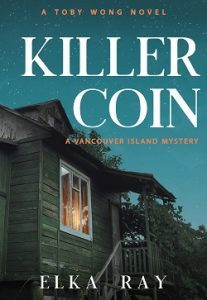 A wealthy socialite goes missing… a battered body is found in her abandoned cabin…
A wealthy socialite goes missing… a battered body is found in her abandoned cabin…
At the center of it all lies the witty and down-to-earth divorce lawyer, Toby Wong. How did she manage to get wrapped up in all of this…again?
All Toby wanted was to settle into island life and start working on her own love story—torn between the wealthy and charismatic Josh Barton, and the adorable and dependable detective Colin Destin.
But Toby’s romantic prospects take the back burner when her mom’s best friend, Daphne Dane, disappears. Toby soon discovers that Daphne’s latest boyfriend is both an alleged conman and the cheating husband of her newest client. Could he be behind Daphne’s disappearance? What about Daphne’s children, vying for their aging mother’s money?
When a dead body is uncovered that entwines both Colin and Josh with the Dane family drama, Toby begins to realize her own life may be in danger.
Equal parts cozy mystery and romantic suspense, the second novel in Elka Ray’s Vancouver Island mystery series will keep you up late with a twisty tale of rivalry, love, money, and murder.
BUY HERE
Tags: featured, women writers
Category: On Writing
The post Why do we write? Elka explains some of her reasons on Books By Women first appeared on Elka Ray - Mystery – Suspense - Noir.
Elka chats about Divorce Is Murder and the writing life with the PNW Kings River Life magazine
Nov 2, 2019 | 2019 Articles, Mysteryrat’s Maze, Sandra Murphy
by Sandra Murphy
This week we have a review of Divorce is Murder by Elka Ray, and an interesting interview with her. Details at the end of this post on how to enter to win a copy of Divorce is Murder. We also have a link to order it from Amazon, and from an indie bookstore where a portion goes to help support KRL.
Divorce is Murder: A Toby Wong series by Elka Ray
Review by Sandra Murphy
Toby Wong is a lawyer. She moved away years ago but is back in her hometown because her mom was diagnosed with cancer. She loves her mom, but there are two bones of contention between them—Mom’s repeated question “Have you met anyone?” and the fact that her mom is a psychic via tarot cards. Toby’s best friend thinks this is very cool, but then again, she doesn’t have to live with it, so to speak.
When Toby was a pre-teen, she and her BFF, Quinn, went to summer camp. Events there didn’t go Toby’s way, and she’s never gotten over it. Now she’s seeing all the same Mean Girls, and they haven’t gotten any better. 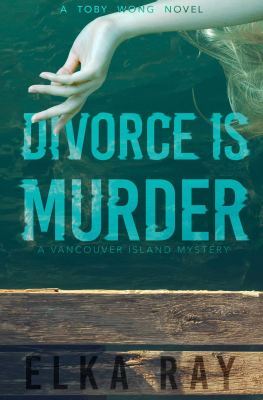
When one of them turns up dead, Toby is hired to represent the dead woman’s husband. How awkward is it that Toby had a huge crush on him at camp? As things get more complicated, Toby has to ask, could current events stem from those long ago days at camp?
This is the first book in a new series, introducing Toby, a Chinese Canadian lawyer. Toby is a likable character, someone you’d certainly want to call if you were arrested. She’s determined to find out the truth, even at her own risk. Her friend Quinn is funny and a great bestie. She’s pregnant so look for more complications coming up, once the baby arrives. Mom is delightful – quirky, funny, and not too Mom-ish, except to Toby.
Readers will enjoy the twists and turns this story takes and look forward to the next.
Sandra Murphy lives in the shadow of the Arch in St. Louis Missouri. She writes about eco-friendly topics, pets and wildlife for magazines and reviews mysteries and thrillers for KRL. A collection of her short stories, published by Untreed Reads, From Hay to Eternity: Ten Tales of Crime and Deception can be found at all the usual outlets. Each one is a little weird and all have a twist you won’t see coming.
Interview with Elka Ray:
KRL: How long have you been writing?
Elka: For eons. When I was twelve, I wrote a story about some scheming rabbits. The teacher told my mom I’d grow up to be a writer.
KRL: When did your first novel come out? What was it called? Can you tell us a little about it?
Elka: My first novel, Hanoi Jane, came out in 2011. It was a light, fun mystery about a girl with a broken heart who sought romantic revenge but ended up finding so much more. Sadly, the publishers marketed it as Chick Lit, which was awful timing as it came out just after Chick Lit was officially declared “dead.”
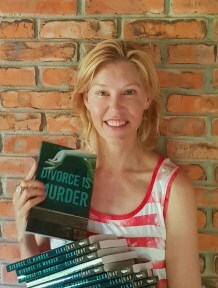
Elka Ray
KRL: Have you always written mysteries/suspense? If not, what else have you written?
Elka: Well, according to my first publisher I wrote Chick Lit! I still do, in a way, although the term has fallen out of favor. My books tend to be about and aimed at women. Yet lots of guys read them. I’m always surprised that many of my best reviews come from men. They enjoy the humor. No matter what I write, it must contain a mystery. That’s what tugs readers forward. I read many genres but if there’s no mystery – and by that, I mean something I need to know – I’ll stop reading.
KRL: What brought you to choose the setting and characters in your latest book/series?
Elka: Divorce Is Murder is set where I grew up, in Victoria, B.C., on Canada’s Vancouver Island. It’s popular with tourists thanks to its gardens and stunning coastal scenery. My books are set in the nicest neighborhoods, which are very picturesque and charming. How I love to commit (fictional!) crimes in idyllic venues… I mistrust places – and people – who look too good to be true. What’s lurking beneath the manicured surface?
The book’s main character, Toby Wong, is a divorce lawyer. As a kid, my best friend’s mom was one. My first-ever job was filing and photocopying in her office – the first all-women law firm in Western Canada. I’d see ladies trail into her office, weeping. A good divorce lawyer does more than just ensure a fair settlement. They’re also part counselor and part cheerleader, supporting clients through a major upheaval. There’s a lot of scope for drama – making this job perfect for a mystery series.
KRL: Do you write to entertain or is there something more you want the readers to take away from your work?
Elka: First and foremost, I’m an entertainer! Most of us are too tired and busy to slog through dull prose hoping to learn something. Of course, I’d like readers to gain more than just fun from my stories. Fiction expands our understanding of human nature, both good and bad. It lifts us into someone else’s shoes and makes us more empathetic.
KRL: Do you have a schedule for your writing or just write whenever you can?
Elka: As well as writing, I’m a paid editor. That takes about half my time. I have a strict schedule, working 8 a.m. to 3-ish. I usually eat lunch at my desk. Sometimes, I’ll take a quick break to race to the beach, which lies two minutes from my house. A lot of my “work” gets done while I walk or swim. That’s when plots and voices come to me, and how I untangle plot snarls.
KRL: If you had your ideal, what time of day would you prefer to write?
Elka: I’m neither a morning nor a night person but a middle-of-the day, after strong coffee person.
KRL: Do you have a great rejection/critique or acceptance story you’d like to share?
Elka: If I had to estimate how many times my work has been rejected 500 times would be a low guess. I don’t think there’s an agent alive (and some not) who has not rejected me! Yet I now have my dream-agent and am seeing real progress. If you’re hearing endless NOs, keep writing and improving. Perseverance pays off.
KRL: Future writing goals?
Elka: Along with the Toby Wong Vancouver Island mystery series, I write darker, scarier suspense. I like to mix it up – fast, fun mysteries and heavier, issue-driven thrillers. This fits my life philosophy. It’s all about Yin and Yang, or the balance of opposites.
KRL: What do you read?
Elka: Nowadays I read mostly crime. Favorite authors include the UK’s Tana French, Belinda Bauer, and Sabine Durrant; Australians Jane Harper and Liane Moriarty; and my fellow Canadian mystery author Louise Penney. As a kid I read all the classics, from Treasure Island to Fahrenheit 451, plus popular YA. In my twenties and early thirties, I read almost exclusively literary fiction. I now find most literary fiction too depressing. While mysteries deal with heavy topics, the solution serves as resolution – something that’s often lacking in real life.
KRL: Any advice for aspiring or beginning writers?
Elka: Instead of trying to sound smart or eloquent just tell your story as simply and honestly as you can.
KRL: What is something people would be surprised to know about you?
Elka: This New Year’s Eve will mark 25 years since I moved to Vietnam. I came “for one year” and never left! After 20 years in huge, polluted cities I’m now incredibly grateful to live in a small fishing village on the beach. A “big night out” now involves walking the dog or taking a night swim when the ocean is full of bright blue phosphorescence.
KRL: Where can people find you online?
Elka: Website: elkaray.com
instagram.com/elka.ray
Facebook: facebook.com/elkaraybooks
Strangely, and against all expectations, I’ve become something of an Instagram addict. When I first joined, I thought it was all girls in bikinis riding skateboards and urban nomads living in vans. But slowly I found my creative tribe – readers, writers, artists, and folk with all sorts of strange passions. Beyond the book people like @contraryreader, @ocinneide1 and @readingdarling, who are obvious favorites, I’m obsessed with a German woman who paints moody girls – @stephanie.steinhardt_14; a talented knitter – @craftymrsriley; and a landscape photographer who makes me homesick for Canada – @zalam604.
To enter to win a copy of Divorce is Murder, simply email KRL at krlcontests@gmail[dot]com by replacing the [dot] with a period, and with the subject line “divorce,” or comment on this article. A winner will be chosen November 9, 2019. U.S. residents only. If entering via email please include your mailing address (so if you win we can get the book sent right out to you), and if via comment please include your email address. You can read our privacy statement here if you like.
Check out other mystery articles, reviews, book giveaways & mystery short stories in our mystery section. And join our mystery Facebook group to keep up with everything mystery we post, and have a chance at some extra giveaways. Be sure to check out our new mystery podcast too with mystery short stories, and first chapters read by local actors.
Use this link to purchase the book & a portion goes to help support KRL & indie bookstore Mysterious Galaxy:
 Divorce Is Murder: A Toby Wong Novel
Divorce Is Murder: A Toby Wong NovelThe post Elka chats about Divorce Is Murder and the writing life with the PNW Kings River Life magazine first appeared on Elka Ray - Mystery – Suspense - Noir.
Elka discusses books and expat life with Thailand’s Phanganist Magazine
Elka Ray writes fast-paced romantic mysteries and scary thrillers – a dichotomy that reveals her belief in Yin and Yang, or the balance of opposites. A great lover of scientific facts, she may be found clutching crystals for good luck; reads highbrow journals and tabloid trash, and refuses to watch romcoms yet moved in with her now-husband on their first date. Elka is the author of three novels and lives with her family near Hoi An, Vietnam.
Hi Elka, how has Hoi An been during this time of Covid-19?
It’d be hard to pick a safer spot than Vietnam to wait out this pandemic, with only 355 cases here to date and no deaths. The authorities took the disease really seriously from the start, sealing the borders, contact-tracing like crazy, and putting tens of thousands in quarantine. They even tracked sales of cold meds at pharmacies to ID potential hotspots!
Thanks to strict and early interventions, life is pretty normal at the moment (early July 2020) – except there are no international flights or foreign visitors. Hoi An’s a tourist town so it’s suffering.
You have lived in Vietnam for 25 years, what were some of the deciding factors for you to stay?
When I arrived in Vietnam, in 1995, the country was newly opened to foreigners. Every single day I saw something that made me stop and think ‘Wait! What’s going on?’ So curiosity drew me onward.
About ten years in, I was thinking about leaving when I met my husband, who’s Australian-Vietnamese. For a while, we kept saying “five more years”. Now, it’s pretty clear we’re going nowhere. Our friends are here. Our family is here. We still see a lot of opportunities. I feel incredibly lucky to have grown up with and in Vietnam.
As a mother of two children in Asia, what are some great things about having and bringing up kids there?
Five years ago, when my kids were six and eight, we moved from Ho Chi Minh City – a crowded city of nine million, to a small fishing village by the beach in Central Vietnam. It’s been life-changing.
In the city, our kids were limited to living in cars and compounds. Here, they can walk or ride their bikes to their friends’ places. Just last week the end-of-school-year party was held near our house on the beach.
My kids hold three passports and have spent their whole lives – barring holidays – in Vietnam. They’re lucky to go to a good small international school where they’ve made friends from all over the globe. That multiculturalism is a blessing.
and any downsides?
Expat life can be transient. Good friends move away. Kids grow up and leave to study overseas. The plus side is that you literally have friends all over the world. The downside is that you miss having them here.
How did you first sustain yourself living in Vietnam?
I spent years working for local magazines and doing communications and PR work for big companies.
Do you get a lot of inspiration for your writing from living there?
While I suspect I’d have found writing inspiration anywhere, Southeast Asia has given me endless material. For one thing, so much of life happens outdoors here – young couples flirting, market ladies arguing… Very little is private. If you’re a writer, you’re a people-watcher. There’s always something to see. Add to that the peculiarities of ex-pat communities. There’s a lot of pettiness and privilege. For a mystery writer, that’s a gold mine.
Any key advice for fiction writers who are or would like to be based in Asia?
Foster an online community. I found mine at – of all places! – Instagram. It’s allowed me to connect with bookish people all over the world. Otherwise, it’s easy to feel isolated.
Many people dream of moving to Asia to live on a beach, what advice can you give?
Get to know a place first. Many people go somewhere on holiday, fall in love with it, and mistake that for real life. If at all possible spend a few months somewhere before you full-on commit. And don’t start a business until you’ve made friends-for-life local friends.
Any ‘home-truths’ people should know about the real beach life?
I’ve been on the beach full-time for five years now and still can’t believe I got so lucky. My kids, however, treat going to the beach like a chore! My thirteen-year-old son just informed me his dream is to live over a mall…
What can you tell us about what you’re working on this year?
My next mystery, KILLER COIN, is due out from Seventh Street Books in November 2020. It’s the second book in my Toby Wong series, about a Canadian divorce lawyer who gets embroiled in a missing person’s case on Vancouver Island. So it’s set on a different type of beach – the tree-lined rocky coastline where I grew up. This book’s definitely a beach read – a page-turning mix of romance, mystery and murder.
And leave us with your ‘life philosophy’….
Be curious.
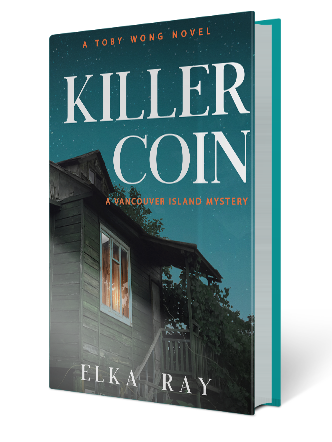 Killer Coin by Elka Ray
Killer Coin by Elka RayKeep updated with phanganist.com by following our Facebook page.
The post Elka discusses books and expat life with Thailand’s Phanganist Magazine first appeared on Elka Ray - Mystery – Suspense - Noir.
The fab horror and mystery author and book critic C.S. O’Cinneide interviews Elka about writing and so much more
Elka Ray is a Canadian/UK author, editor, and illustrator. For adults, Elka writes crime, and is the author of three novels – the upcoming romantic mystery Divorce is Murder, due out with Seventh Street/Prometheus in June 2019; Saigon Dark (2016), a noir thriller; a lighter mystery, Hanoi Jane(2011); and a collection of short crime stories: What You Don’t Know: Ten Tales of Obsession, Mystery & Murder in Southeast Asia (2016).
Her children’s picture books focus on Vietnam, where she lives by the beach with her family. When Elka’s not writing, reading, or drawing, she’s in the ocean.
The ocean is a big part of your life. You live by it and dream by it. Tell us about that.
After twenty-plus years living in huge, congested cities, going on four years ago my family moved to the beach in Central Vietnam. When I’m tired, frustrated, or dispirited I walk two minutes to the sea. All the little things that build up and get to you get washed away in the ocean.
Even as a kid I had dreams about the sea: looking through clear water to see fish swimming around; jumping killer whales; tsunamis. I think it relates to the subconscious and creativity – trying to peer into it and not knowing what might leap out – and possibly eat you.
Your books range from domestic noir and tales of murder to beach read mysteries and children’s books where people are smelly. Which genre do you like writing the best and why?
I like to read and write stories about crimes or morally questionable choices. If no one’s screwing up, there’s no story.
Divorce is Murder comes out next summer, your third novel. Sounds like domestic noir, but will it be more of a beach read?
It’s a mystery set on Vancouver Island, where I grew up. There’s a murder, loads of suspense, and some romantic angst, all narrated by a wryly funny main character – Toby Wong, a Chinese-Canadian divorce lawyer. It’s perfect for the beach – fast-paced and edgy, but light enough to read while guzzling Pina Coladas.
I love that the mean girls from Toby Wong’s teen years’ summer camp are suspects in Divorce is Murder. Girls can be so nasty at that age. Why do you think that is?
Insecurity. Adolescents are like scared cats, hissing and puffing themselves up. Boys can be mean too but it seems simpler – more physical and less psychological. Maybe it’s because society is always telling girls to be nice. All that aggression goes underground.
Saigon Dark, your second novel, has an underlying theme of fate and how it affects our lives. How much do you think fate has influenced your own life? Is life truly “a box of chocolates?”
I think many people believe they’re the agents of their success. They credit their intelligence, creativity, and hard work for getting ahead. Of course these traits help but they’re not the whole story. You might be a genius and blessed with mind-blowing talent, but if you’re born into a poor peasant family during a famine in some war stricken pariah state, odds are you won’t reach your full potential. When I think of “fate” I think of family and citizenship. I had the great good fortune to grow up with a loving family in a stable, peaceful country that gave me access to good education and healthcare.
Humour is a big part of your writing style. Even a noir like Saigon Dark has some. Tell us a joke in Vietnamese. Then put it into Google Translate and let’s see how bad a job it does.
I can’t recall any humor in Saigon Dark but am pleased some crept in. This question has been a nightmare. Lost in translation doesn’t begin to cover it. Every Vietnamese “joke” I’ve been told has been the opposite of funny, leaving me feeling baffled and defective. In place of “jokes” I was told riddles. As in:
Có một người da đen kết hôn với một người da trắng, sau đó họ có 1 em bé. Hỏi em bé đó có răng màu gì?
Which translates as:
A white person married a black person and had a baby. What color are its teeth?
My lame guess: Um, mixed?
Answer: Babies don’t have teeth.
I much prefer Google Translate’s version:
There is a black man who marries a white man, then they have a baby. Ask the baby what color teeth?
Answer: Rainbow.
Hanoi Jane, your first novel, gives me a sort of Sex in the City vibe, Vietnamese style. Tell us about your inspiration for the characters and the setting, and whether you were Carrie Bradshaw or Samantha Jones.
Yes, Hanoi Jane was written during the last gasps of the ‘Chick Lit’ era. I wrote it when I had a small baby, was sleep-deprived, and needed cheering up. It was a rose-tinted look back at being young, carefree, and single. In reality, I was neither Carrie nor Samantha. I’m much more reserved. Even watching them embarrassed me. While I’m happy for everyone who’s having good sex – and am fine with writing sex scenes – the thought of sitting around listening to people discuss it in real life sounds about as appealing as wearing that heinous tutu.
Your upcoming novel, Divorce is Murder, is your first set outside of Southeast Asia. How do the wilds of British Columbia stack up against the exoticness of Vietnam and who has the best coffee?
Setting a murder mystery in Victoria, B.C., where I grew up, was fun. Victoria is gorgeous, with beautiful coastal scenery, endless parks, and really quaint, picturesque neighborhoods. In fact it’s so serene I don’t trust the place: what’s happening behind those manicured hedges? Seeming perfection makes me nervous.
As the title suggests, Saigon Dark was mainly set in Saigon. It’s a much darker, more desperate tale – perfect for that grittier setting.
As for the coffee – Vietnamese coffee is stronger. I don’t travel without it.
I read in a previous interview (obviously not as weird as mine) that you were inspired to write your first book of short stories, What You Don’t Know: Ten Tales of Obsession, Mystery & Murder in Southeast Asia, after reading Andrew Pyper’s Lost Girls. What other authors or books have inspired you in your writing?
Animal Farm: I read this aged 12. When Boxer got carted off to the knackers I cried until my eyes glued shut. This taught me how powerfully fiction can get a point across.
A Tale of Two Cities: I was about 14 when I read it and have never forgotten Madame Defarge, who sits and knits as aristocrats’ heads are cut off. The message was clear: there’s nothing as memorable as a good villain with a strong backstory.
In the Skin of a Lion: I read Michael Ondatje’s novel about the building of Toronto in my 20s. I found the plot impossible to follow. But who cares? There were a few scenes – like the one when they’re ice skating on a torchlit lake – so luminous I swear I was there. This book taught me the power of poetic language.
A Simple Plan. Scott Smith’s 1993 thriller turned me to a life of reading – and later writing – crime. It’s about a few guys who find a bag of cash in a crashed plane and do the wrong thing. Scott doesn’t just make you understand their actions. He makes you complicit.
If you were to bury one book in a time capsule for future generations to find, what would it be?
Goodnight Moon. It’s by far the creepiest book I’ve ever read. Is that why small kids love it? Imagine future social scientists trying to decode the symbolism. What does the Moon represent? What is Mush?
To find out more about Elka Ray and her books, see below.
www.facebook.com/elkaraybooks/
www.goodreads.com/author/show/5027427.Elka_Ray
The post The fab horror and mystery author and book critic C.S. O’Cinneide interviews Elka about writing and so much more first appeared on Elka Ray - Mystery – Suspense - Noir.
The Crime Cafe with Elka Ray
The post The Crime Cafe with Elka Ray first appeared on Elka Ray - Mystery – Suspense - Noir.
What is Noir? Get Elka’s take on The Librarian Reads:
As an author, editor and avid reader, I’m excited to have been invited to write a guest post for The Librarian Talks.
My name’s Elka Ray. I write crime fiction, mystery, suspense and noir.
If you’re like me, up until fairly recently, I didn’t actually know what noir was. So I’m going to explain it today.
Noir is the French word for Black – which is a clue. There stories are not about rainbows and unicorns – it’s a dark genre.
Noir has its roots in the hard-boiled private eye stories of the 1920s – you know the kind – gritty tales of violence, murder, dirty cops and dangerous dames. What sets noir apart from those hardboiled PI stories is the main character – in those old PI stories, while the world around them is grim, you know the hero’s a good guy trying to do the right thing. That is not the case in noir. In noir, you’re not really sure if the lead is a good person. Can they justify what they’re doing? Maybe. Is it morally right? That’s trickier to answer.
It’s this moral ambiguity that defines noir.
My latest book – Saigon Dark – is noir and follows a woman who – faced with tragedy – makes a terrible choice. She’s not necessarily a bad person – but she is selfish, isolated and deceitful. In noir, the main character is often cynical and self destructive. A modern day example would be Gone Girl – you just can’t trust the main point of view. Or The Girl on the Train. The main character is not doing herself any favors.
Another great example of a contemporary noir author is Dennis Lehane. In Live by Night, for example, he leaves you questioning whether a gangster can be a good person. If you want your stories to be black and white – with a happily ever after ending – noir is not for you. But if you like mysteries that are complex and thought-provoking, give this genre a try.
You can find my latest book – A Friend Indeed at elkaray.com – Happy reading!
Read MoreThe post What is Noir? Get Elka’s take on The Librarian Reads: first appeared on Elka Ray - Mystery – Suspense - Noir.
Elka Ray: detailing her life, loves, and books
The post Elka Ray: detailing her life, loves, and books first appeared on Elka Ray - Mystery – Suspense - Noir.
Back on CrimeReads, Elka examines traditional motives for fictional murders: Love, Lust, Loathing, and Loot:
Has Greed Fallen Behind as a Motive for Murder in Modern Crime Fiction?A look at the traditional motives for killing: Love, Lust, Loathing, and Loot.
Four motives are typically given for murder, namely Love, Lust, Loathing, and Loot. Researching this, I discovered a 2017 FBI report that claimed a whopping 41 percent of murders in the USA that year occurred during “arguments” or “brawls”.
Crime writers—and readers—have no interest in brawls that got out of hand. It’s terribly depressing to learn someone lost their life for no deep reason. In crime novels, we seek to learn who, when, where, what, how and—most importantly—why. These solutions restore our faith in an orderly universe.
That same 2017 FBI data showed that nine percent of murders were linked to Theft, while 14 percent were tied to Drugs & Gangs. I’m putting both in the Loot category. Only two percent were classified as Sex killings, which you’d never guess if you read modern crime fiction. Meanwhile, the FBI lumped a wildly unsatisfying 24 percent into Other. No crime writer could get away with this.
The FBI’s data confirms that Loot—ie Greed—is a major motive for real life murder. A quick trawl through true crime sites backs this up. We’re all too familiar with tales of robbery gone wrong; botched kidnappings; ugly divorces in which one or both partners won’t share; and the subjects of multi-million-dollar life insurance policies meeting untimely demises.
Greed, or Avarice, is the third of the Seven Deadly Sins, which most people assume have Biblical origins but actually trace back to the ancient Greeks. Like its cousins, Lust and Gluttony, Greed is a sin of desire. Of the Seven Sins, the ancients considered Pride worst of all, since it allows us to place our own selfish goals over others’ wellbeing.
While the Seven Sins list predates Christianity, it was the Christians who added the “Deadly”. They felt these emotions had the power to “maim” or “kill” the divine spirit within human beings.
Now back to Greed, and crime fiction. Money’s a factor behind many real murders, but in recent crime stories, Greed seems to lag behind motives deemed sexier or more psychologically complex, including Jealousy, Love, and Revenge.
I think there’s an erroneous sense that, so far as motives go, Greed is simple. Pondering what motivated crime way back in 387 A.D., St. Augustine seemed to argue this when he said: “So when people look for the reason why some criminal act has been committed their account is only rendered credible when it is evident that there may have been Greed on the malefactor’s part to gain possession of goods belonging to someone else…”
Greed’s logical, Saint Augustine seems to say, while other motives are slippery. Yet Saint Augustine soon admits some thefts make no sense, by describing how, as a teen, he and his hoodlum mates stripped a neighbor’s pear tree purely for the thrill of it. As he put it:
Behold, now let my heart confess to thee what it was seeking there, when I was being gratuitously wanton, having no inducement to evil but the evil itself.
In Saint Augustine’s case, what seemed like a crime of Greed was likely motivated by boredom, raging hormones, and peer pressure.
Of course, nicking your neighbor’s pears isn’t the same as killing your neighbor. But by resorting to blaming his actions on “evil”, Saint A was admitting what we all know: even we don’t understand what motivates us all of the time.
To complicate matters further, there’s someone’s actual motive and then there’s the way they justify their misdeeds. As the crime novelist Josephine Tey said: “If you think about the unthinkable long enough it becomes quite reasonable.”
While Greed seems to have fallen behind in modern crime books, it plays a starring role in many old tales, from Dickens’ 1843 A Christmas Carol to Dashiell Hammet’s 1929 noir detective treasure hunt The Maltese Falcon to Steinbeck’s 1947 sob-fest The Pearl. It was the 1950s that brought us crime ficiton’s Greed poster boy in the form of Patricia Highsmith’s mesmerizing The Talented Mr. Ripley. Eighties’ Wall Street Greed is the background of Tom Wolfe’s The Bonfire of the Vanities, which begs for a reread in today’s #BLM context. Then there’s my favorite Greed read of all time, Scott Smith’s 1993 A Simple Plan, about a trio who find a bag of cash in a crashed plane. It’s impossible to read this one without wondering: What would I do?
My interest in Greed as a motive for murder—both real and fictional—dates back to a double-homicide in my home town, Canada’s Victoria, B.C., which is also the setting of my Toby Wong Vancouver Island mystery series.
In 1990, a boy at my high school convinced two of his classmates to help him stab his mom and grandma to death. The motive? A $CDN 4-million inheritance. One of the accomplices confessed, served out his sentence, and was paroled in 2003. Despite convincing physical evidence, the mastermind and his other pal never admitted guilt and remain in jail.
What, beyond money, would convince a kid to kill his own mother and grandmother? It wasn’t just the cash, obviously.
Questions like this led me to Killer Coin, the second book in my mystery series. The story pivots upon Greed, as the vultures—in the form of a gold-digging boyfriend and money-hungry kids—start circling an aging socialite.
Greed, especially the kind that wrecks families, fascinated me even before my high schoolmate committed matricide. Greed runs in my family history.
My mom, a twin, was raised by abusive parents in Berlin, just after the Second World War. When her parents weren’t hitting her they were inciting her much-bigger twin brother to do it for them. At the age of seventeen, with nothing but a black eye and the clothes on her back, my mom fled to a homeless shelter—and never went back. Her grandmother, whom my mom loved, left all she had to her twin grandchildren. Not surprisingly, my mom never got her share of Grannie’s estate. Looking on the bright side, no one was murdered.
That’s not the case in my favorite fictional family sagas. Inheritance Greed lies behind Josephine Tey’s diabolical doppelganger drama Brat Farrar. Arthur Connan Doyle tackles the same ground and provides an equally ingenious, if somewhat improbable, solution in The Speckled Band. And no one did greedy relatives better than the Queen of Crime, Agatha Christie. Check out Sparkling Cyanide, in which a family fortune inspires poisoned champagne or Endless Night, a tale of marrying into money, madness, and murder.
What Agatha knew is that Greed doesn’t kill alone but with a gang of Deadly Sin accomplices. Envy starts things off, while Sloth lends a hand since making legit money ain’t easy! Resentment grows into Wrath, which does the dirty work. And Pride’s always there, egging Greed on with promises that more dosh will lead to the respect, love, and power the killer’s so sure he deserves.
I’m going to leave you with a link to my favorite true crime podcast about familial Greed. It’s a quick listen and involves no deaths, but is chilling.
We all know the sea’s full of sharks eager to feast on your flesh and blood. Sadly, some of them are your flesh and blood.
Read More
 Killer Coin by Elka Ray
Killer Coin by Elka RayThe post Back on CrimeReads, Elka examines traditional motives for fictional murders: Love, Lust, Loathing, and Loot: first appeared on Elka Ray - Mystery – Suspense - Noir.

